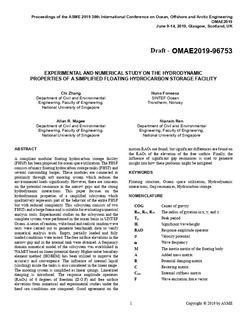| dc.contributor.author | Zhang, Chi | |
| dc.contributor.author | Fonseca, Nuno | |
| dc.contributor.author | Magee, Allan R. | |
| dc.contributor.author | Ren, Nianxin | |
| dc.date.accessioned | 2019-11-19T11:51:21Z | |
| dc.date.available | 2019-11-19T11:51:21Z | |
| dc.date.created | 2019-11-13T10:49:37Z | |
| dc.date.issued | 2019-06 | |
| dc.identifier.citation | ASME 2019 38th International Conference on Ocean, Offshore and Arctic Engineering (OMAE2019): Volume 6: Ocean Space Utilization | nb_NO |
| dc.identifier.isbn | 978-0-7918-5883-7 | |
| dc.identifier.uri | http://hdl.handle.net/11250/2629271 | |
| dc.description.abstract | A compliant modular floating hydrocarbon storage facility (FHSF) has been proposed for ocean space utilization. The FHSF consists of many floating hydrocarbon storage tanks (FHST) and several surrounding barges. These modules are connected in proximity through soft mooring system which reduces the environmental loads significantly. However, there are concerns on the potential resonance in the narrow gaps and the strong hydrodynamic interactions. This paper focuses on the hydrodynamic properties of a simplified subsystem which qualitatively represents part of the behavior of the entire FHSF but with reduced complexity. This subsystem consists of two FHSTs and a barge frame and is suitable for evaluating numerical analysis tools. Experimental studies on the subsystem and the complete system were performed in the ocean basin in SINTEF Ocean. A series of random, wide-band and realistic random wave tests were carried out to generate benchmark data to verify numerical analysis tools. Empty, partially loaded and fully loaded conditions were tested. The free surface elevations in the narrow gap and in the internal tank were obtained. A frequency domain numerical model of the subsystem was established in WAMIT based on linear potential theory. Higher order boundary element method (HOBEM) has been utilized to improve the accuracy and convergence. The influence of internal liquid (sloshing) inside the tanks is also considered in the linear range. The mooring system is simplified as linear springs. Linearized damping is introduced. The response amplitude operators (RAOs) of 6 degrees of freedom (D.O.F) and free surface elevations from numerical and experimental studies under the head sea conditions are compared. Good agreement on the motion RAOs are found, but significant differences are found on the RAOs of the elevation of the free surface. Finally, the influence of significant gap resonances is used to generate insight into how these problems might be mitigated. | nb_NO |
| dc.language.iso | eng | nb_NO |
| dc.publisher | ASME Press | nb_NO |
| dc.relation.ispartof | ASME 2019 38th International Conference on Ocean, Offshore and Arctic Engineering (OMAE2019): Volume 6: Ocean Space Utilization | |
| dc.relation.ispartofseries | OMAE2019;96753 | |
| dc.rights | Attribution-NonCommercial-NoDerivatives 4.0 Internasjonal | * |
| dc.rights.uri | http://creativecommons.org/licenses/by-nc-nd/4.0/deed.no | * |
| dc.subject | Floating structure | nb_NO |
| dc.subject | Ocean space utilization | nb_NO |
| dc.subject | Hydrodynamic interactions | nb_NO |
| dc.subject | Gap resonance | nb_NO |
| dc.subject | Hydrocarbon storage | nb_NO |
| dc.title | Experimental and Numerical Study on the Hydrodynamic Properties of a Simplified Floating Hydrocarbon Storage Facility | nb_NO |
| dc.type | Chapter | nb_NO |
| dc.description.version | acceptedVersion | nb_NO |
| dc.identifier.doi | 10.1115/OMAE2019-96753 | |
| dc.identifier.cristin | 1746934 | |
| cristin.unitcode | 7566,9,0,0 | |
| cristin.unitname | Skip og havkonstruksjoner | |
| cristin.ispublished | true | |
| cristin.fulltext | postprint | |
| cristin.qualitycode | 1 | |

